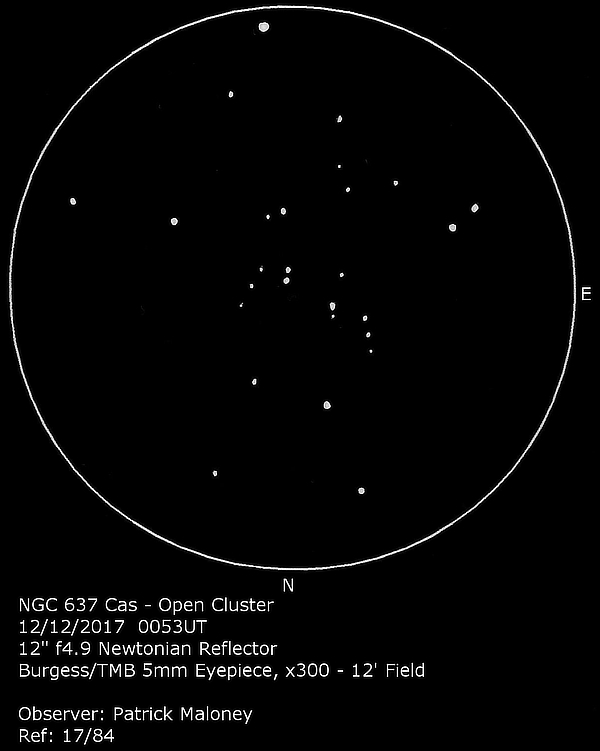NGC 637 in Cassiopeia
October 2024 - Nebula and Cluster of the Month
During October, the northern Milky Way rides high, close to the zenith for British observers. Taking centre stage are the rich galactic star fields of Cassiopeia, a constellation bursting with open clusters.
William Herschel, the doyen of deep-sky observers, discovered 14 open clusters in Cassiopeia, including this month’s object. He catalogued it as 49 H.VII, that is the 49th entry in his seventh catalogue (‘Pretty much compressed clusters of large or small stars’). He found the cluster on the night of 9 November 1788 and described it as A cluster of some considerably large stars and many extremely small so as hardly to be seen. The large stars [are] arranged in circular order, 3 or 4’ diameter.
The cluster was added to the New General Catalogue by J. L. E. Dreyer in 1888 and was assigned the catalogue number NGC 637. It is included in the Herschel 400, one of the 99 open clusters included in that list.
NGC 637 is 1.3° west and slightly north of ε Cassiopeiae (Segin), the easternmost and, at magnitude 3.3, the faintest of the five stars that make up Cassiopeia’s ‘wonky W’.
It transits close to midnight towards the end of October at an altitude of 80° from mid-Britain.
The cluster is relatively bright at magnitude 8.2. Most listings agree that it contains 20 member stars and that the brightest member has a magnitude of 9.97. Archinal & Hynes, however, in their Star Clusters argue for 55 stars, the brightest of which, they say, is magnitude 8.0. There are, however, no stars as bright as magnitude 8.0 within, or even very near, the cluster.

Estimates of the Trumpler type vary, as they so often do. Two of my sources opt for I2m (detached with strong central condensation, moderate range in stellar brightness, medium rich (50 – 100 stars)). I am aware that this is at odds with the assertion that the cluster has only 20 members. The Night Sky Observer’s Guide goes with I3p (detached with strong central condensation, wide stellar magnitude range, poor (< 50 stars)).
The cluster is young, estimated to be about ten million years old. Its distance is reported as 2400pc (7800 light-years), placing it in the Perseus arm of the Milky Way.
With four (or five) known examples, NGC 637 is one of the clusters best endowed with β Cephei-type variable stars. β Cephei stars (also known as β Canis Majoris stars) are short-period, small-amplitude pulsating stars. These pulsations are particularly useful for asteroseismology, the study of the interiors of stars from their pulsations.1
There are several published visual observations of NGC 637. From these observations, several features stand out: in small telescopes, the five brightest stars, which are arranged in a short arc, give the cluster a crescent-shaped appearance. Observations with mid-range telescopes (8—10”, 200—250mm) frequently mention the double star near the centre of the group whose components are magnitudes 10.2 and 10.9 (usually quoted as 10 and 11) with a separation of nine seconds of arc. I can find no observation that records any colour for these stars.
I made my observation of this cluster in 2017, from my home location using a 12” (300mm) Newtonian reflector. The conditions were poor, as they always are. The sky was bright and snow on the ground enhanced the brightness. I should add that my observation was made in December, not in October.

I found the cluster to be small and fairly compressed. It was best seen at fairly high power (x300). It is well detached from the background. The stars that I could see ranged in brightness from magnitude 10 to about 14.5. I estimated the size of the cluster to be a little under 10’. Within that 10’, I counted 27 stars. It is attractive and pleasing to the eye.
For what it’s worth, my visual take on the Trumpler classification for this object is I3p.
| Object | RA | Dec | Type | Magnitude |
|---|---|---|---|---|
| NGC 637 | 01h 43m 08s | +64° 02’ 06” | Open cluster | 8.2 |
References:
- New β Cephei stars in the young open cluster NGC 637, G. Handler & S. Meingast, Astronomy & Astrophysics vol 53, September 2011.